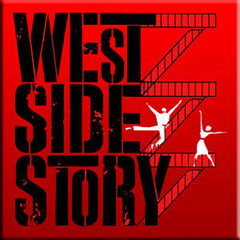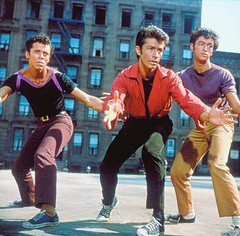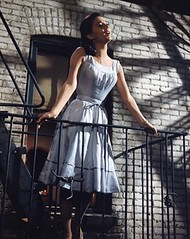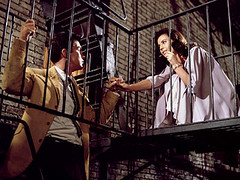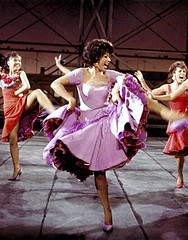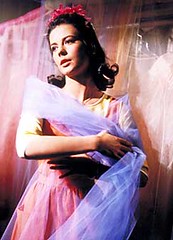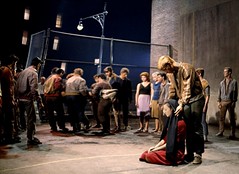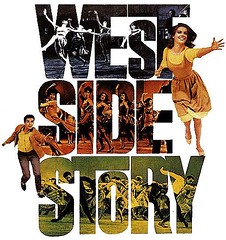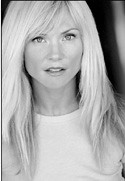WEST SIDE STORY
Your December Unrandom Movie Club Results Are In!
Tagline: THE MOST ACCLAIMED MOTION PICTURE OF OUR TIME!
Pizza: Joe Peep's
Preshow Entertainment: None
HOMEO AND JEWLIET
Yep. It took four gay Jews to make one of the best (if not the best) modern musicals. Leonard Bernstein's score, Stephen Sondheim's lyrics, Jerome Robbins' choreography and Arthur Laurents' book have all conspired to create a masterpiece. Broadway and movie musicals have morphed (think MOULIN ROUGE) since the Golden Age (think OKLAHOMA), but boy, boy, crazy boy this film holds up exceptionally well for a 50 year old. And who'd have thought NYC gang members could get away with those terpsichorean moves. Imagine trying that in BOYZ N THE HOOD.
WSS opens with something you don't have too often in movie musicals these days - an overture. Hell, even Broadway musicals don't do much of that anymore. WSS's overture could win a rumble against any show, which means we hear Bernstein's genius at work before we see any characters. We're actually watching what looks like a UPC code transform into the Manhattan skyline.
 And so begins the modern day (late 50s modern, that is) story, lifted from Shakespeare's ROMEO AND JULIET. This version takes place in New York City, home of street gang the Jets, now led by Riff (Russ Tamblyn, Amber's dad and my future father-in-law). The Jets' territory is being encroached upon by the recently emigrated Puerto Rican gang, the Sharks, and what starts off as a turf war (done in its new genre "tough guy ballet") becomes a love story. A love story that's doomed from the start.
And so begins the modern day (late 50s modern, that is) story, lifted from Shakespeare's ROMEO AND JULIET. This version takes place in New York City, home of street gang the Jets, now led by Riff (Russ Tamblyn, Amber's dad and my future father-in-law). The Jets' territory is being encroached upon by the recently emigrated Puerto Rican gang, the Sharks, and what starts off as a turf war (done in its new genre "tough guy ballet") becomes a love story. A love story that's doomed from the start.
Riff is just so cool. He was when I saw the movie when I was a kid and he is now. Riff in that jacket, speaking daddy-o lines, flicking that cigarette, balancing on that pole, he was the real Buddy Love. Riff tells us that you're a Jet "from your first cigarette to your last dying day." How cool is that?
In order to challenge rival Bernardo (George Chakiris) and his Sharks to a rumble, Riff must enlist ex-Jet top cat/now working-man Tony (Richard Beymer) to join him. Though Tony has hung up his street-gang ballet slippers, he agrees, out of their undying friendship. And it's at this dance that Tony and Bernardo's sister Maria (Natalie Wood) meet and instantly click. In the next two hours songs will be sung, dances danced and fights fought. And these violent delights will have violent ends.
Some changes were made when WSS transitioned from stage (1957) to screen (1961). Dialogue like "From sperm to worm" became "from birth to earth." And lyrics went from "My father is a bastard, my ma's an SOB" to "My daddy beats my mommy, my mommy clobbers me". And in the TONIGHT QUINTET, Anita's "As long as he's hot" became "As long as he's near." Tame and almost laughable changes by today's standards (SHREK has more "offensive" language..."eat me!"), but I suppose they were needed. My favorite change is also in the TONIGHT QUINTET, when Riff and Tony are meant to yell out (once again) "sperm to worm", they now yell out "1, 2, 3!" I have to believe it was someone's "fuck you" to censorship.
A change that I'm wholeheartedly behind is the song order; moving the playful GEE, OFFICER KRUPKE from after the murders (why was it there to begin with?) to earlier in the film, leaving COOL in its rightful place. But all these structural and lyrical changes mean little when looking at the overall accomplishment.
Winner of ten Academy Awards, WEST SIDE STORY was directed by Robert Wise and Jerome Robbins. The show itself was Robbins' baby, having come up with the idea in 1947. At that time, it was a religious wedge (Catholic boy/Jewish girl) that made the love forbidden, and it was called EAST SIDE STORY. It took a full ten years to retool, regroup, and launch WSS as what we know today.
When it came time to make the movie, Robbins demanded directorship or he wouldn't sell. The compromise was to co-direct with Wise, who would do all the drama while Robbins did all the dance numbers. But Robbins was a workhorse and a perfectionist. He was notoriously tough on dancers, who he pushed until they were injured, and in one case, hospitalized. It's said that after COOL was wrapped, the cast burned their kneepads in front of Robbins' door. And because he kept changing things on the set, it wasn't long before they were over-budget and behind schedule (a two week location shoot took over two months). Alas, poor Jerome was removed a little over halfway into the shoot.
Wise, who edited CITIZEN KANE and would soon direct THE SOUND OF MUSIC as well as genre-hop with movies like 1983's STAR TREK: THE MOTION PICTURE (can you imagine McCoy doing that outstretched leap?), was more low-key. But who's to say that if Robbins wasn't there to drive those songs, WSS would still be what it is. Not me. Because the choreography is thrilling. Busting with energy ("Bust cool!"), it's really something special. Tamblyn tumbled (he was surely a gymnast), Chakiris was classy and Moreno a spitfire. And whenever the Jets and the Sharks were together (the winning prologue, the dance at the gym, the rumble), it was electric. ODD NOTE: Both Tamblyn and Beymer would appear three decades later in TWIN PEAKS.

I'm not sure any movie comes close to the number of showstoppers that WSS has. It's almost ridiculous to the point where you want to applaud your TV screen (audiences applauded in the theaters as well as at the box office, where WSS ran 77 weeks). Though it's hard for me to choose a favorite, COOL ranks way high, right to the very last note when the Jets are looking up and...right at us. But did they really break the fourth wall? After a cut, we see they're still looking up...at something. Us? Who knows? But it sure was COOL.
And now a word about the music: Wow.
Beneath Leonard Bernstein's jazz-soaked score you'll find lush strings, brassy mambo and melodic and emotional ballads, and you probably know most of them. Time signatures that fit seamlessly yet confounded the dancers. Memorable melody lines (when was the last time you saw a show and left humming one of its songs, let along all of them? I thought so...). Songs have been covered by just about everyone, from Barbra Streisand to Tom Waits, from Buddy Rich (whose live show often featured his WEST SIDE STORY MEDLEY, which I was fortunate enough to see a few times) to Todd Rundgren. From GLEE to prog rockers Yes. Hell, even Phil Collins tried but couldn't ruin SOMEWHERE.
After this viewing, I got such a bad case of Music From WSS Fever that I watched a DVD called LEONARD BERNSTEIN CONDUCTS WEST SIDE STORY. What a fantastic documentary. Yeah, so you've seen WSS and you don't want to watch it again (shame on you). Then at least watch this documentary (Netflix). It's thrilling. No joke. Thrilling. Perhaps the best thing I've seen all year.
When I was in 6th grade, we had an assignment to, well, I don't really remember what it was. All I remember was I read the novelization of WEST SIDE STORY and rewrote it as a science fiction story about two planets that didn't get along. There were the MontaSharks and the CapuJets. The planet was named Wesit, hence the story's title - WESIT STORY. I remember that novelization well. It was small and hard-covered and red. I wish I still had it. I wish I still had WESIT STORY. What happens to these things? In the trash with the now priceless baseball cards, I suppose.
If I had to find a weakness in WSS, it would be in the acting. With a few exceptions (Rita Moreno as Anita shines, and Ned Glass' Doc can make you whimper), it's all pretty flat. Save for Natalie "Meteor" Wood. Her performance in the last few minutes is killer. Metaphorically, of course.
Speaking of performances; though it's well known that singer Marni Nixon dubbed Wood's singing voice, I was surprised to learn that she wasn't the only one dubbed; Tamblyn, Beymer, even Moreno (only on A BOY LIKE THAT).
There are others to credit for WEST SIDE STORY, like lyricist Stephen Sondheim (don't get me started...I may not stop), storyteller Ernest Lehman (Really? This script and NORTH BY NORTHWEST?) and effects pioneer Linwood Dunn who worked with Wise on KANE (someone should name a theater after him). And the wonderful production design and colors provided by designer Boris Leven. Though most of the movie was shot on sound stages, many exteriors were shot where Lincoln Center stands today, before what was there was torn down (I think they paid the city to postpone construction so they could shoot freely on the streets).
You must be tired of me gushing, but the truth is you're getting off easy because WEST SIDE STORY isn't even my favorite musical. But it's up there at #5. And no, I didn't tear up this time. But when no one was around, I watched it again so I could work on this write-up and okay, it got to me. So yeah, I buggin' love WEST SIDE STORY. And if you don't, well then Krup you.
Tagline: THE MOST ACCLAIMED MOTION PICTURE OF OUR TIME!
Pizza: Joe Peep's
Preshow Entertainment: None
HOMEO AND JEWLIET
Yep. It took four gay Jews to make one of the best (if not the best) modern musicals. Leonard Bernstein's score, Stephen Sondheim's lyrics, Jerome Robbins' choreography and Arthur Laurents' book have all conspired to create a masterpiece. Broadway and movie musicals have morphed (think MOULIN ROUGE) since the Golden Age (think OKLAHOMA), but boy, boy, crazy boy this film holds up exceptionally well for a 50 year old. And who'd have thought NYC gang members could get away with those terpsichorean moves. Imagine trying that in BOYZ N THE HOOD.
WSS opens with something you don't have too often in movie musicals these days - an overture. Hell, even Broadway musicals don't do much of that anymore. WSS's overture could win a rumble against any show, which means we hear Bernstein's genius at work before we see any characters. We're actually watching what looks like a UPC code transform into the Manhattan skyline.
 And so begins the modern day (late 50s modern, that is) story, lifted from Shakespeare's ROMEO AND JULIET. This version takes place in New York City, home of street gang the Jets, now led by Riff (Russ Tamblyn, Amber's dad and my future father-in-law). The Jets' territory is being encroached upon by the recently emigrated Puerto Rican gang, the Sharks, and what starts off as a turf war (done in its new genre "tough guy ballet") becomes a love story. A love story that's doomed from the start.
And so begins the modern day (late 50s modern, that is) story, lifted from Shakespeare's ROMEO AND JULIET. This version takes place in New York City, home of street gang the Jets, now led by Riff (Russ Tamblyn, Amber's dad and my future father-in-law). The Jets' territory is being encroached upon by the recently emigrated Puerto Rican gang, the Sharks, and what starts off as a turf war (done in its new genre "tough guy ballet") becomes a love story. A love story that's doomed from the start.Riff is just so cool. He was when I saw the movie when I was a kid and he is now. Riff in that jacket, speaking daddy-o lines, flicking that cigarette, balancing on that pole, he was the real Buddy Love. Riff tells us that you're a Jet "from your first cigarette to your last dying day." How cool is that?
In order to challenge rival Bernardo (George Chakiris) and his Sharks to a rumble, Riff must enlist ex-Jet top cat/now working-man Tony (Richard Beymer) to join him. Though Tony has hung up his street-gang ballet slippers, he agrees, out of their undying friendship. And it's at this dance that Tony and Bernardo's sister Maria (Natalie Wood) meet and instantly click. In the next two hours songs will be sung, dances danced and fights fought. And these violent delights will have violent ends.
Some changes were made when WSS transitioned from stage (1957) to screen (1961). Dialogue like "From sperm to worm" became "from birth to earth." And lyrics went from "My father is a bastard, my ma's an SOB" to "My daddy beats my mommy, my mommy clobbers me". And in the TONIGHT QUINTET, Anita's "As long as he's hot" became "As long as he's near." Tame and almost laughable changes by today's standards (SHREK has more "offensive" language..."eat me!"), but I suppose they were needed. My favorite change is also in the TONIGHT QUINTET, when Riff and Tony are meant to yell out (once again) "sperm to worm", they now yell out "1, 2, 3!" I have to believe it was someone's "fuck you" to censorship.
A change that I'm wholeheartedly behind is the song order; moving the playful GEE, OFFICER KRUPKE from after the murders (why was it there to begin with?) to earlier in the film, leaving COOL in its rightful place. But all these structural and lyrical changes mean little when looking at the overall accomplishment.
Winner of ten Academy Awards, WEST SIDE STORY was directed by Robert Wise and Jerome Robbins. The show itself was Robbins' baby, having come up with the idea in 1947. At that time, it was a religious wedge (Catholic boy/Jewish girl) that made the love forbidden, and it was called EAST SIDE STORY. It took a full ten years to retool, regroup, and launch WSS as what we know today.
When it came time to make the movie, Robbins demanded directorship or he wouldn't sell. The compromise was to co-direct with Wise, who would do all the drama while Robbins did all the dance numbers. But Robbins was a workhorse and a perfectionist. He was notoriously tough on dancers, who he pushed until they were injured, and in one case, hospitalized. It's said that after COOL was wrapped, the cast burned their kneepads in front of Robbins' door. And because he kept changing things on the set, it wasn't long before they were over-budget and behind schedule (a two week location shoot took over two months). Alas, poor Jerome was removed a little over halfway into the shoot.
Wise, who edited CITIZEN KANE and would soon direct THE SOUND OF MUSIC as well as genre-hop with movies like 1983's STAR TREK: THE MOTION PICTURE (can you imagine McCoy doing that outstretched leap?), was more low-key. But who's to say that if Robbins wasn't there to drive those songs, WSS would still be what it is. Not me. Because the choreography is thrilling. Busting with energy ("Bust cool!"), it's really something special. Tamblyn tumbled (he was surely a gymnast), Chakiris was classy and Moreno a spitfire. And whenever the Jets and the Sharks were together (the winning prologue, the dance at the gym, the rumble), it was electric. ODD NOTE: Both Tamblyn and Beymer would appear three decades later in TWIN PEAKS.

I'm not sure any movie comes close to the number of showstoppers that WSS has. It's almost ridiculous to the point where you want to applaud your TV screen (audiences applauded in the theaters as well as at the box office, where WSS ran 77 weeks). Though it's hard for me to choose a favorite, COOL ranks way high, right to the very last note when the Jets are looking up and...right at us. But did they really break the fourth wall? After a cut, we see they're still looking up...at something. Us? Who knows? But it sure was COOL.
And now a word about the music: Wow.
Beneath Leonard Bernstein's jazz-soaked score you'll find lush strings, brassy mambo and melodic and emotional ballads, and you probably know most of them. Time signatures that fit seamlessly yet confounded the dancers. Memorable melody lines (when was the last time you saw a show and left humming one of its songs, let along all of them? I thought so...). Songs have been covered by just about everyone, from Barbra Streisand to Tom Waits, from Buddy Rich (whose live show often featured his WEST SIDE STORY MEDLEY, which I was fortunate enough to see a few times) to Todd Rundgren. From GLEE to prog rockers Yes. Hell, even Phil Collins tried but couldn't ruin SOMEWHERE.
After this viewing, I got such a bad case of Music From WSS Fever that I watched a DVD called LEONARD BERNSTEIN CONDUCTS WEST SIDE STORY. What a fantastic documentary. Yeah, so you've seen WSS and you don't want to watch it again (shame on you). Then at least watch this documentary (Netflix). It's thrilling. No joke. Thrilling. Perhaps the best thing I've seen all year.
When I was in 6th grade, we had an assignment to, well, I don't really remember what it was. All I remember was I read the novelization of WEST SIDE STORY and rewrote it as a science fiction story about two planets that didn't get along. There were the MontaSharks and the CapuJets. The planet was named Wesit, hence the story's title - WESIT STORY. I remember that novelization well. It was small and hard-covered and red. I wish I still had it. I wish I still had WESIT STORY. What happens to these things? In the trash with the now priceless baseball cards, I suppose.
If I had to find a weakness in WSS, it would be in the acting. With a few exceptions (Rita Moreno as Anita shines, and Ned Glass' Doc can make you whimper), it's all pretty flat. Save for Natalie "Meteor" Wood. Her performance in the last few minutes is killer. Metaphorically, of course.
Speaking of performances; though it's well known that singer Marni Nixon dubbed Wood's singing voice, I was surprised to learn that she wasn't the only one dubbed; Tamblyn, Beymer, even Moreno (only on A BOY LIKE THAT).
There are others to credit for WEST SIDE STORY, like lyricist Stephen Sondheim (don't get me started...I may not stop), storyteller Ernest Lehman (Really? This script and NORTH BY NORTHWEST?) and effects pioneer Linwood Dunn who worked with Wise on KANE (someone should name a theater after him). And the wonderful production design and colors provided by designer Boris Leven. Though most of the movie was shot on sound stages, many exteriors were shot where Lincoln Center stands today, before what was there was torn down (I think they paid the city to postpone construction so they could shoot freely on the streets).
You must be tired of me gushing, but the truth is you're getting off easy because WEST SIDE STORY isn't even my favorite musical. But it's up there at #5. And no, I didn't tear up this time. But when no one was around, I watched it again so I could work on this write-up and okay, it got to me. So yeah, I buggin' love WEST SIDE STORY. And if you don't, well then Krup you.
